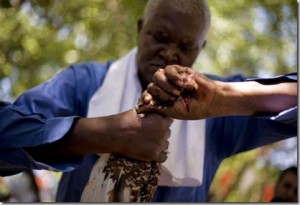Lancashire Voodoo c. 1850 December 26, 2011
Author: Beach Combing | in : Modern , trackbackBeach promised no more fairy stories in 2011 but he thought he would go out with a witch tale from nineteenth-century Lancashire on the wrong side of the Pennines. There is something reminiscent of an earlier post from Hebden Bridge here and also of the curious case of the witch who suffered spontaneous combustion in Suffolk. Most interesting it seems to have come from a reliable first-hand source: the book dates to the late 1860s.
(208) Some years ago I formed the acquaintance of an elderly gentleman who had retired from business, after amassing an ample fortune by the manufacture of cotton. He was possessed of a considerable amount of general information – had studied the world by which he was surrounded – and was a leading member of the Wesleyan connexion. The faith element, however, predominated amongst his religious principles, and hence both he and his family were firm believers in witchcraft. On one occasion, according to my informant, both he and the neighbouring farmers suffered much from loss of cattle, and from the unproductiveness of their sheep. The cream was bynged [soured] in the churn, and would bring forth no butter. Their cows died mad in the shippons, and no farrier could be found who was able to fix upon the diseases which afflicted them. Horses were bewitched out of their stables through the loopholes, after the doors had been safely locked, and were frequently found strayed to a considerable distance when they ought to have been safe in their stalls. Lucky-stones had lost their virtues; horseshoes nailed behind the doors were of little use; and sickles hung across the beams had no effect in averting the malevolence of the evil-doer.
At length suspicion rested upon an old man, a noted astrologer and fortune-teller, who resided near New Church, in Rossendale, and it was determined to put an end both to their ill-fortune and his career, by performing the requisite ceremonials for ‘killing a witch’. It was a cold November evening when the process commenced. A thick fog covered the valleys, and the wild winds whistled across the dreary moors. The farmers, however, were not deterred. They met at the house of one of their number, whose cattle were then supposed to be under the influence of the wizard; and having procured a live cock-chicken, they stuck him full of pins and burnt him alive, whilst repeating some magical incantation. A cake was also made of oatmeal, mixed with the urine of those bewitched, and, after having been marked with the name of the person suspected, was then burnt in a similar manner The wind suddenly rose to a tempest and threatened the destruction of the house. Dreadful moanings as of some one in intense agony, were heard without, whilst a sense of horror seized upon all within. At the moment when the storm was at the wildest, the wizard knocked at the door, and in piteous tones desired admittance. They had previously been warned by the ‘wise man’ whom they had consulted, that such would be the case, and had been charged not to yield to their feelings of humanity by allowing him to enter. Had they done so, he would have regained all his influence, for the virtue of the spell would have been dissolved. Again and again did he implore them to open the door, and pleaded the bitterness of the wintry blast, but none answered from within. They were deaf to all his entreaties, and at last the wizard wended his way across the moors as best he could. The spell, therefore, was enabled to have its full effect, and within a week the Rossendale wizard was locked in the cold embrace of Death.
Beach loves the idea of ‘a leading member of the Wesleyan connexion’, i.e. a tee-totalling, pontificating, go-to-chapel-on-sunday-even-with-a-cold Methodist carrying out a voodoo ceremony on the Lancs moors sometime in the middle of the nineteenth century.
A theme that repeats itself in these late witchcraft accounts is the way that the offended against are far more diabolical (at least in terms of the proof given) than the offenders.
Any other late witch accounts, 1750 plus? Drbeachcombing AT yahoo DOT com



